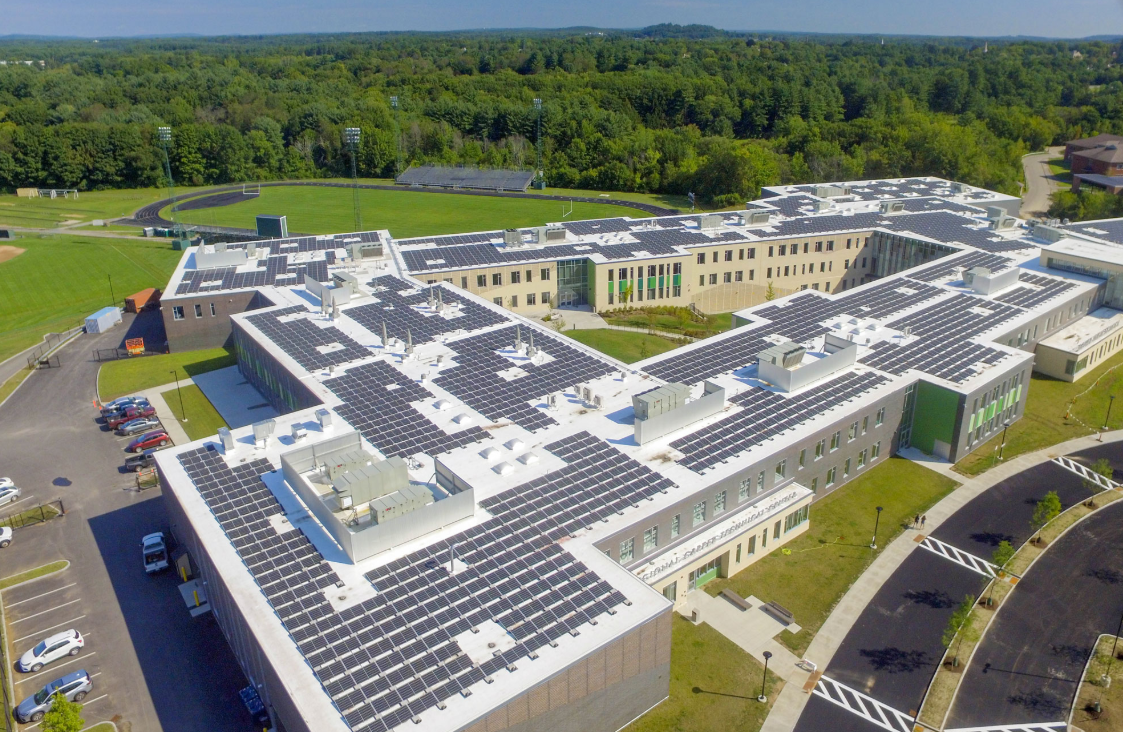The information contained in this article is not intended as legal advice and may no longer be accurate due to changes in the law. Consult NHMA's legal services or your municipal attorney.

Solar has become the renewable energy of choice for municipalities throughout northern New England because it is now cost-competitive with fossil fuels and has zero carbon emissions. Since 1975 the cost of solar technology has dropped by 99%, creating the opportunity for New Hampshire towns and cities to derive a strong economic and environmental return on a solar investment while meeting citizens’ urgent calls to reduce carbon pollution.
But is there truly enough sunshine at our latitude to justify a solar investment? In fact, much of New Hampshire is at the same latitude as Monaco on the French Riviera, one of the sunniest vacation destinations in Europe.
It may surprise folks to learn that a solar array in New Hampshire will generate roughly the same amount of clean, renewable solar electricity per year as an array in Houston, TX. This is due to New Hampshire’s relatively sunny latitude, and to the fact that solar panels are much more efficient at lower temperatures. Annually, New Hampshire gets 33% more sunshine than Germany, a world leader in solar adoption that is situated at a more northerly latitude.
Zero up front cost is one of the strongest drivers of solar adoption by towns and cities, enabled by the common financial approach known as a ‘Power Purchase Agreement’, or PPA. Instead of directly purchasing a solar array, municipalities are partnering with local, mission-driven impact investors (like the New Hampshire Community Loan Fund) who finance the construction of the solar project, after which the city or town simply agrees to purchase the solar electricity at a rate below what the utility charges for brown power from the grid.
For the first five years of the Power Purchase Agreement, the solar array is owned by the investors on behalf of the municipality during what is called the ‘tax recapture period.’ Since the investors benefited from the 26% federal tax credit for solar, and the accelerated depreciation benefit, the solar array cannot be sold at a deep discount to the municipality until the five years have elapsed to avoid clawback of the federal tax incentives. Starting in Year 6, the municipality has the option to purchase the solar array from the investors at roughly 60% of the initial construction cost, or to simply keep buying the clean solar electricity at a rate that is indexed to local utility rates with the goal of keeping solar power costs lower than grid power.
Readers can learn more about this approach here: https://impact.revisionenergy.com/
Modern, reliable solar technology comes with a 25-year warranty and an expected useful lifespan of 40+ years, making it possible for municipalities to save hundreds of thousands of dollars on energy costs over the multi-decade operational life of an array. Because the local NH solar resource is measurable and predictable, solar developers can accurately model the savings from a solar array and provide municipalities with transparent financial proformas before making the decision to enter into a typical 20-year PPA (with buyout options starting in Year 6).
 Dover NH High School Solar Project
Dover NH High School Solar ProjectTo date a slew of New Hampshire municipalities, schools and nonprofits have entered into successful PPA’s, including the largest rooftop solar array in the state at Dover High School, along with the cities and towns of Concord, Hanover, Lebanon, Nashua, Durham, Lee, Stratham, Peterborough, Keene, Plymouth and many more. Colby-Sawyer College, Dartmouth, Phillips Exeter, Proctor, Nashua Soup Kitchen, Children’s Museum of NH, Palace Theater, and Tupelo Music Hall are a few other recognizable New Hampshire institutions that are saving serious amounts of money and reducing carbon emissions through solar PPA’s.
With coal-fired power plants like Schilling Station in Bow, plus 350,000 homes heated by oil and 525,000 gas-powered cars on the road, New Hampshire has the second highest per capita carbon pollution in New England. Every year, New Hampshire exports roughly $4 billion from the local economy to import fossil fuels from away. The good news is that cost-effective solar, combined with hyper-efficient technologies like heat pumps, electric vehicles, batteries and LEDs, now makes it possible for all New Hampshire cities, towns and households to pivot away from fossil fuels, save money and protect New Hampshire’s pristine natural environment from the carbon pollution that threatens everyone’s way of life.
Phil Coupe is co-founder of Revision Energy, a Certified B. Corp. Phil can be reached by phone at 207.232.6595 or via email at phil@revisionenergy. com. ReVision Energy is 100% employee owned and operated. Their team of in-house solar specialists (engineers, designers, installers) has built over 7,000 solar energy systems in the region. They are a Certified B Corp and have been consistently rated Top 10 Solar Installers in the Northeast.